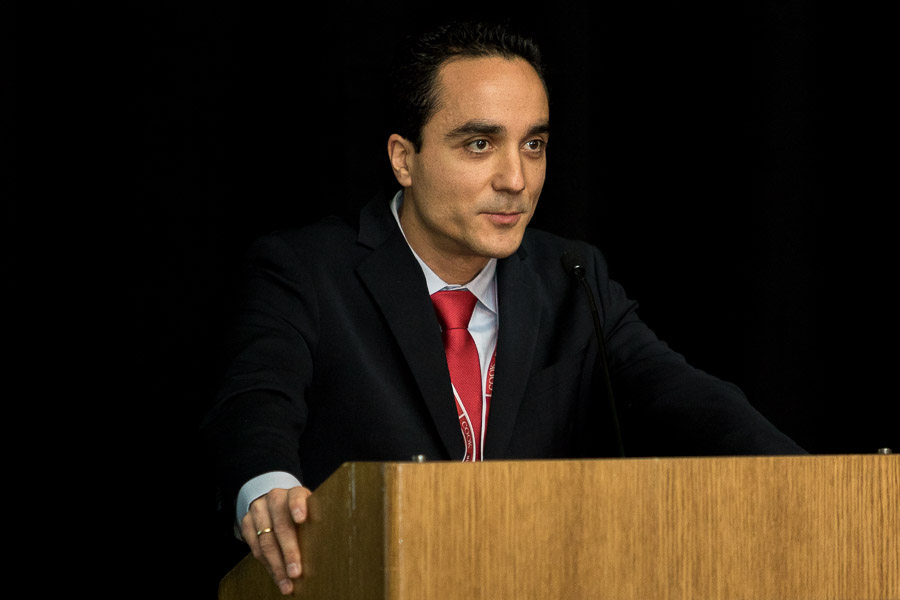
The Standard vs ultrasound-assisted catheter thrombolysis for submassive pulmonary embolism (SUNSET sPE) trial, is an ongoing randomised, head-to-head, single-blinded clinical trial comparing ultrasound-assisted thrombolysis to standard catheter-directed thrombolysis. While comparative data is not yet available, Efthymios “Makis” Avgerinos (University of Pittsburgh Medical Center, Pittsburgh, USA) presented the interim results of the overall outcomes at the Society for Vascular Surgery (SVS) Vascular Annual Meeting (VAM; 12–15 June, National Harbor, USA) in a late-breaking scientific session.
Introducing the presentation, Avgerinos explained that pulmonary embolism is classified in three categories, based on mortality risk: from non-massive low (mortality <1%) or intermediate (submassive) (3-15%) risk, up to massive pulmonary embolism with mortality risk up to 30% or more. Calculating the appropriate care for PE therefore similarly creates a scale of intervention, from anticoagulation alone to systemic thrombolysis—“as severity increases, we need to escalate our treatment”, said Avgerinos.
Catheter-directed interventions for the treatment of patients with submassive pulmonary embolism (sPE) have shown promise in rapidly improving right heart strain and preventing decompensation to massive pulmonary embolism, Avgerinos and colleagues state in their abstract. Ultrasound assisted thrombolysis has been in the fore front of these interventions and it has been shown that—at least in vitro—ultrasound can enhance thrombus breakdown, he explained. If this can be translated to clinical practice the potential benefits can be multiple. However, Avgerinos noted at VAM, “it is unclear whether ultrasound-assisted thrombolysis is clinically superior to thrombolysis provided by a standard multisidehole catheter. […] There is a lot of literature supporting EKOS (BTG), and right now it is the only FDA approved thrombolytic catheter that we have for pulmonary embolism, but the reality is that there is norobust evidence of clinical superiority to justify a 10 times increased cost compared to the standard catheter.”
The SUNSET sPE trial, he explained, is therefore enrolling adult patients presenting to the University of Pittsburgh Medical Center with sPE, based on a multidisciplinary pulmonary embolism response team algorithm. Participants are randomised 1:1 to treatment with EKOS or standard catheter thrombolysis. The study began in 2017 and anticipates completion in spring of 2020, according to Avgerinos.
The primary endpoint is thrombus reduction assessed by post-procedure CT angiogram, and the study is powered for 80 patients to detect a 50% improvement in pulmonary artery thrombus clearance. Secondary outcomes include 48-hour RV/LV ratio improvement by CT pulmonary arteriogram, and three- and 12-month functional capacity and quality-of-life measures.
“We are presenting 45 patients today, but we have recently enrolled our 49th patient,” Avgerinos reported, 23 in the EKOS arm and 22 in the standard catheter arm (mean age 55.0 ± 15.0, 62.2% male, 66.7% with concurrent DVT), all with acute sPE.
On average, patients were lysed for 13 hours (±6 hours). The investigators outline their results in the abstract: The mean RV/LV ratio was reduced from 1.59±0.29 at baseline to 1.11±0.23 within 48 hours. One (2.2%) major (haemorrhagic stroke) with no neurologic deficits by discharge and two (4.4%) minor bleeding episodes were observed during the post-interventional period. At 30 and 90 days, there were no deaths and no recurrent venous thromboembolism.
Avgerinos underlined these findings at VAM, highlighting that “there was no decompensation and no associated mortality”. Looking at functional capacity, a six-minute walking test at three months showed a 22% exercise intolerance or dyspnea at rest, while 56% developed “very light or light” dyspnea after a six-minute walk. “Regarding the quality of life,” Avgerinos said, “it was not as good as you would expect for the general population, but still the scores did not qualify for a poor quality of life.”
Comparative data is set to be announced at the completion of the study enrolment—“hopefully early next year”, said Avgerinos, “but we can conclude that catheter thrombolytic techniques can achieve significant quick thrombus and RV/LV ratio reduction, and that catheter thrombolysis is safe and effective”











